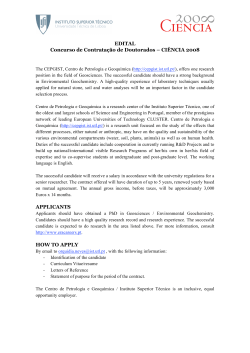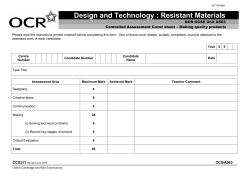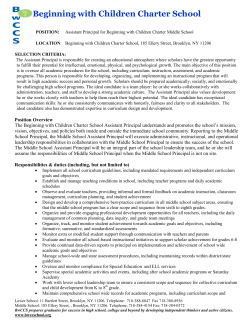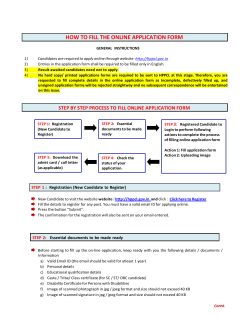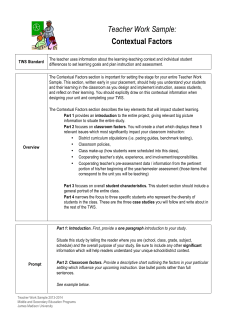
TEACHER WORK SAMPLE
Adelphi University Ruth S. Ammon School of Education EARLY CHILDHOOD PROGRAM TEACHER WORK SAMPLE Manual for Teacher Candidates and Student Teacher Supervisors: Overview of TWS 7 Teaching processes TWS Standards Tasks Indicators (Directions) Rubric The materials in this document were developed by The Renaissance Partnership for Improving Teacher Quality Project http://fp.uni.edu/itq Some of the materials have been adapted for use with the Early Childhood Graduate Program at Adelphi University. (December 2nd , 2008) Overview of THE TEACHER WORK SAMPLE (TWS) A Teacher Work Sample (TWS) is a performance-based assessment process that enables teacher candidates to demonstrate teaching performances directly related to the implementation of a standards-based instructional unit by planning, instructing and assessing students. Teacher candidates analyze student learning and reflect on their teaching effectiveness. The TWS provides substantial evidence that teacher candidates are ready to begin a professional career as an educator. The development of a TWS will provide teacher candidates with an authentic experience designed to develop in them “a teacher’s way of thinking.” In other words, in their future career the systematic development of a TWS may not happen again in a formal written manner. However, very importantly, it will create a professional habit of mind where, as an educator, they will naturally think about the processes of the TWS as a matter of best practice. The following pages describe the Teacher Work Sample and the seven teaching processes it contains. Each teaching process is introduced in detail with a page that describes what is required (the task) and the indicators that need to be included in each of the processes. At the end of this Manual there is a rubric (to be completed by the supervisor) that describes acceptable or target performance. Please note that all seven processes (plus the written Expression1) need to be met in order to obtain a passing score in the TWS requirement. That is, all processes need to have a score of 3 in the rubric. There are Seven Key Process of a Teacher Work Sample: 1. 2. 3. 4. 5. 6. 7. Contextual Factors Learning Goals Assessment Plan Design for Instruction Instructional Decision-Making Analysis of Student Learning and Self-Evaluation and Reflection The Teacher Work Sample is folded into the Educational Portfolio and documents the teacher candidate's achievements over the course of the Early Childhood program at Adelphi University. The Teacher Work Sample must show satisfactory achievement of the learning outcomes of the School of Education’s Early Childhood Program of study. The format of the Teacher Work Sample may be traditional print and/or electronic file. 1 The Written Expression is not one of the 7 processes but it is part of the rubric. Teacher candidates must use the conventions of standard written English consistently throughout the TWS report. 2 Assignment: Teacher candidates are required to design a comprehensive unit of study in ONE of the Student Teaching placements. The unit needs to have at least FIVE lesson plans. Teacher candidates are required to teach at least TWO of these five lesson plans and these will become the TWS. Before the teacher candidate teaches the lessons, he or she will describe contextual factors, identify learning goals based on the New York State Standards and NAEYC Standards (see www.naeyc.org), create an assessment plan designed to measure student performance before (pre-assessment), during (formative assessment) and after (post-assessment), instruction and plan for instruction. After the teacher candidate teaches the lessons, he or she will analyze student learning and then reflect upon and evaluate their teaching as related to student learning. Suggested Schedule for teacher candidates: Week #1: Meet with the Cooperating Teacher to discuss TWS schedule/requirements Complete Contextual Factors section By the end of the first ¼ of the placement: Plan a unit (with five lessons) with the cooperating teacher. Planning together is very important because you have to plan a unit that will be meaningful, developmentally appropriate, and coherent with the class curriculum. Complete the Learning Goals and Assessment Plan Give pre-assessment to students (make a copy of student papers/work) Analyze pre-assessment data and use results to complete Design for Instruction section Select 2 students whose formative assessments you will collect during the unit. By the end of the third ¼ of the placement: Teach at least 2 lessons of the unit Collect student work as needed Take notes for the Instructional Decision Making section By the end of the placement: Give post-assessment Analyze post-assessment results and complete rest of TWS 3 Teaching Processes, Standards, Tasks and Indicators There are 7 Teaching Processes assessed by the TWS: 1. Contextual Factors Standard: The teacher candidate uses information about the learning/teaching context and student individual differences to set learning goals and objectives, plan instruction, and assess learning. Task: Discuss relevant factors and how they may affect the teaching/learning process. Include any supports and challenges present that affect instruction and student learning. Indicators: In your discussion, include: • Community, District, and School Factors Address geographic location, community and school population, socio-economic profile, and race/ethnicity. You might also address such things as stability of community, political climate, community support for education, and other environmental factors. • Classroom Factors Address physical features, availability of equipment and resources, and the extent of parental involvement. You might also discuss other relevant factors such as classroom rules and routines, grouping patterns, scheduling, and classroom arrangement. • Student Characteristics Address age, gender, race/ethnicity, special needs, achievement/developmental levels, and students’ skills and prior knowledge relevant to your learning goals. You might also include relevant factors such as culture, language, interests, and learning styles/modalities. Suggested Page Length: 1-2 4 2. Learning Goals Standard: The teacher candidate sets significant, challenging, varied, and appropriate learning goals and objectives. Task: Provide and justify the learning goals and objectives for each lesson plan. Indicators: List the learning goals and objectives (not the activities) that will guide the planning, delivery, and assessment of your lesson plans. These goals and objectives should define what you expect students to know and be able to do at the end of each lesson. Number or code each learning goal and objective so you can reference it later. Provide justification for your choice of learning goals and objectives. Elements of your justification should include at least type and level of learning, appropriateness, and alignment with local, state, or national standards. Suggested Page Length: 1-2 3. Assessment Plan Standard: The teacher candidate uses multiple assessment modes and approaches aligned with learning goals and objectives to assess student learning before, during, and after instruction. Task: Design an assessment plan to monitor student progress toward learning goal(s) and objective(s). Use multiple assessment modes and approaches aligned with learning goals and objectives to assess student learning before, during, and after instruction. These assessments should authentically measure student learning and may include performance-based tasks, observations, paper-and-pencil tasks, or personal communication. Describe why your assessments are appropriate for measuring learning. Indicators: • Include a description of pre- and post-assessments that are aligned with your learning goals and objectives. Clearly explain how you will evaluate or score pre- and post-assessments. State what criteria you will use to determine if the students’ performance meets the learning goals and objectives. Include evidence of pre- and post-assessments (copies of the assessments or Indicators and student directions for the Indicators) and criteria for judging student performance. • Discuss your plan for formative assessment that will help you determine student progress during the unit. Describe the indicators you will use to check on student progress and comment on the importance of collecting that particular evidence. Although formative assessments may change as you are teaching the lessons, your task here is to predict at what points in your teaching it will be important to assess students’ progress toward learning goals and objectives. 5 • Construct a table that lists each learning goal and objective, assessments used to judge student performance relative to learning goals and objectives, and adaptations of the assessments for the individual needs of students. The primary purpose of this table is to depict the alignment between learning goals and objectives and assessments. The table also provides opportunities to show where adaptations are going to be implemented to meet the individual needs of students or contextual factors. You must have one table for each lesson plan. LESSON PLAN 1 1) LEARNING GOALS 2) LEARNING OBJECTIVES 3) ASSESSMENTS 4) FORMAT OF ASSESSMENT 5) ADAPTATIONS Learning Goal 1 Learning Objective 1 Pre-Assessment Performance-based, paper-and-pencil, personal communication How will you adapt each assessment for individual needs of students or contextual factors? Formative Assessment(s) Post-Assessment Learning Goal 2 Learning Goal 3, etc. After administering the pre-assessment, analyze student performance relative to the learning goals and objectives. Depict the results of the pre-assessment in a graph or chart, indicating students’ progress toward each learning goal and objective. Discuss how this analysis will guide your instruction or modification of the learning goals and objectives. Suggested Page Length: 2-3 + pre- and post-assessment instruments. • 4. Design for Instruction Standard: The teacher candidate designs instruction for specific learning goals and objectives, student characteristics and needs, and learning contexts. Task: Describe how you will design your instruction related to the goals and objectives, students’ characteristics and needs, and the specific learning context. Indicators: Use the table below to provide an overview of your entire learning unit. Even though you will teach only 2 lessons of this unit, you need to provide an overview of the entire unit. Include the topic or activity you are planning for each day. Also indicate the goal(s) and objective(s) (coded from your Learning Goals and Learning Objectives sections) that you are addressing in each activity. Make sure that every goal and objective is addressed by at least one activity and that every activity relates to at least one goal and objective. Indicate the materials that you will use to conduct each lesson. 6 LESSON 1 LESSON 2 LESSON 3 LESSON 4 LESSON 5 DATE ACTIVITY GOALS MATERIALS • Choose three or four activities that reflect a variety of instructional strategies/techniques and explain why you are planning those specific activities. In your explanation for each activity, include − − − how its content relates to your instructional goal(s) and objective(s), how the activity stems from your pre-assessment information and instructional context, what materials/technology you will need to implement the activity, and how you plan to assess student learning during and/or following the activity (i.e., formative assessment). Suggested Page Length: 3 + block plan − 5. Instructional Decision-Making Standard: The teacher candidate uses on-going analysis of student learning to make instructional decisions. Task: Provide two examples of instructional decision-making based on students’ learning or responses. Indicators: • Think of a time during your lesson when a student’s learning or response caused you to modify your original design for instruction. (The resulting modification may affect other students as well.) Cite specific evidence to support your answers to the following: a. Describe the student’s learning or response that caused you to rethink your plans. The student’s learning or response may come from a planned formative assessment or another source. b. How did your analysis and interpretation of this student’s learning or response inform your decision regarding what you did next? Describe what you did, and explain why you thought this would improve student progress toward the learning goal and objective. Discuss what happened and explain why. • Now, think of one more time during your lesson when another student’s learning or response caused you to modify a different portion of your original design for instruction. (The resulting modification may affect other students as well.) Cite specific evidence to support your answers to the following: o Describe the student’s learning or response that caused you to rethink your plans. The student’s learning or response may come from a planned formative assessment or another source. 7 How did your analysis and interpretation of this student’s learning or response inform your decision regarding what you did next? Describe what you did, and explain why you thought this would improve student progress toward the learning goal and objective. Discuss what happened and explain why. Suggested Page Length: 3-4 o 6. Analysis of Student Learning Standard: The teacher candidate uses assessment data to profile student learning and communicate information about student progress and achievement. Task: Analyze your data to report the performance of the whole class, subgroups, and two individual students. Use visual representations and narrative to profile student performance. Indicators: • Whole class Use aggregated data to draw conclusions about the extent to which the whole class attained all learning goals and objectives. Provide a graphic representation to compare pre- and post-assessment results for each goal and objective. Explain what the graph illustrates and why you think students performed this way. • Subgroups Select a group characteristic to analyze (e.g., gender, performance level, socio-economic status, language proficiency, or other attributes of diversity). Form a subgroup based on that distinguishing characteristic (e.g., male, low performance, free or reduced lunch, ESL). Explain why it is important to understand the learning of this particular subgroup in relation to two significant learning goals and objectives, one of which must represent higher level thinking. Use disaggregated data to draw conclusions about the extent to which the subgroup attained the two learning goals and objectives. Provide a graphic representation to compare pre- and post-assessment results for the two goals and objectives. Explain what the graph illustrates and why you think students in the subgroup performed this way. Individuals Select two students who represent different levels of performance. Explain why it is important to understand the learning of these particular students in relation to two significant learning goals and objectives, one of which must represent higher level learning. Draw conclusions about the extent to which these students attained the two learning goals and objectives and provide examples of student work to support your response. Suggested Page Length: 4 + charts and student work • 8 7. Reflection and Self-evaluation Standard: The teacher candidate analyzes the relationship between his or her instruction and student learning in order to improve teaching practice. Task: Reflect on your performance as a teacher in guiding the instructional process of the lessons and link your performance to student learning results. Evaluate your performance relative to the seven standards of the work sample to identify future actions for improved practice and professional growth. Indicators: • Write a narrative reflecting on instruction and student learning in which you a. describe the instructional strategies or activities that contributed most to student learning and which were most effective, b. explain the greatest barriers to achieving learning results, specifically considering which of these were under your control as a teacher, and c. discuss what you would do differently to improve student learning. • Write a narrative evaluating your effectiveness as an instructor in which you: a. Assess the extent to which you met the work sample standards, focusing specifically on your key areas of strength and weakness. Analyze how your performance on these standards impacted the learning of your students. b. Reflect on your own abilities and identify what professional knowledge, skills, or dispositions (e.g., attitudes, values, and beliefs) would improve your performance in teaching the lessons. Identify specific professional endeavors that would improve your performance. c. Select and discuss your most significant learning insight from teaching this unit. Suggested Page Length: 2 9 Submission Information Use the following information before you submit your TWS: Ownership. Complete a cover page that includes (a) your name, (b) date submitted, (c) grade level taught, (d) subject taught, (e) course number and title. ∑ Table of Contents. Provide a Table of Contents that lists the sections and attachments in your TWS document with page numbers. ∑ Charts, graphs and attachments. Charts, graphs and assessment instruments are required as part of the TWS document. You may also want to provide other attachments, such as student work. However, you should be very selective and make sure your attachments provide clear, concise evidence of your performance related to TWS standards and your students' learning progress. ∑ Narrative length. A suggested page length for your narrative is given at the end of each component section. You have some flexibility of length across components, but the total length of your written narrative (excluding charts, graphs, attachments and references) should not exceed twenty (20) word- processed pages, double-spaced in 12-point font, with 1-inch margins. ∑ References and Credits (not included in total page length). If you referred to another person's ideas or material in your narrative, you should cite these in a separate section at the end of your narrative under References and Credits. You should use the American Psychological Association (APA) for your citations and reference list. ∑ Anonymity. In order to insure the anonymity of students in your class, do not include any student names or identification in any part of your TWS. ∑ 10 Rubric 2 Indicator Partially Met 1 Indicator Not Met The candidate integrates their understanding of the community, school and classroom factors into developmentally appropriate instruction for all children. The candidate clearly understands how the students characteristics and needs make an impact in the learning environment. Goals are developmentally appropriate and are explicitly aligned with NAEYC standards. The candidate displays limited understanding of the learning implications of community, school and classroom factors as well as student characteristics. The candidate displays little, inaccurate or biased knowledge of the learning implications of community, school and classroom factors as well as student characteristics. Goals may not be developmentally appropriate for young children and may not be fully aligned with NAEYC Standards. Goals are not developmentally appropriate and are not align with NAEYC Standards. Assessment Plan: The candidate uses multiple assessment modes and approaches aligned with learning goals to assess student learning before, during and after instruction All learning goals and assessments are aligned, assessments are clear and explicit, the plan includes multiple modes and assesses student performance throughout the instructional sequence. Assessments appear valid, procedures are clearly explained. Adaptations, to meet individual needs are provided. Some learning goals and assessments are aligned, assessment criteria may not be clear. Assessments overly rely on paper and pencil tasks, do not include performance assessment. Some scoring procedures are explained. Adaptations have been made for some students. There is a lack of congruence or alignment between learning goals and assessments. Criteria are not clear or missing. The plan uses one method and does not assess students throughout instruction. Assessments have not been adapted to meet individual student needs. Design for Instruction: The candidate designs instruction for specific learning goals, student characteristics and needs, and learning contexts. All lessons, activities and resources are explicitly linked to learning goals. Content appears accurate and activities are developmentally appropriate. Lessons are logically organized. Significant variety of instructional methods and activities are provided. Most lessons, activities and resources are explicitly linked to learning goals. Content appears mostly accurate. There is some logical organization to the lessons. Some variety of methods and activities is provided. Rating Indicator Contextual Factors: The candidate uses information about the learning/teaching context and student individual differences to set learning goals, plan instruction and assess learning. Learning Goals: The candidate sets significant, challenging, varied and appropriate learning goals. 3 Indicator Met Score Few lessons, activities or resources are explicitly linked to learning goals. Numerous errors in content. Lessons are not logically organized. Little variety of methods or activities. 11 Rating Indicator Instructional decisionmaking: The candidate uses on-going analysis of student learning to make instructional decisions. Analysis of student learning: The candidate uses assessment data to profile student learning and communicate information about student progress and achievement. Reflection and selfevaluation: The candidate analyzes the relationship between his or her instruction and student learning in order to improve teaching practice. 3 Indicator Met 2 Indicator Partially Met 1 Indicator Not Met Instructional decisions are pedagogically sound, appropriate modifications are made to meet student needs. Rationale is based on an analysis of student learning and explains why the modification would improve student progress. Modifications are congruent with learning goals. Instructional decisions are mostly appropriate, but some are not pedagogically sound. Some modifications are made to meet student needs, but are not generally based on an analysis of student learning. Modifications are somewhat congruent with learning goals. Many instructional decisions are inappropriate and not pedagogically sound. Candidate treats class as “one size fits all” and makes no individual modifications, or modifications are not logically related to any analysis of student learning. Presentation is easy to understand and contains no errors of representation. Analysis is fully aligned with learning goals and provides a comprehensive profile of student learning for the whole class, subgroups and two individuals. Interpretation is meaningful and appropriate conclusions are drawn from the data. Analysis includes evidence of the impact on student learning in terms of number of students who made progress toward each learning goal. Presentation is understandable and contains a few errors. Analysis is partially aligned with learning goals and/or fails to provide a comprehensive profile of student learning relative to the goals for the whole class, subgroups, and two individuals. Interpretation is technically accurate, but conclusions are missing or not fully supported by data. Analysis includes incomplete evidence of the impact on students who made progress toward each learning goal. Explores multiple hypotheses for why some students did not meet learning goals. Identifies successful and unsuccessful activities and assessments and provides plausible reasons (based on theory or research) for their success or lack thereof. Logically connects learning goals, instruction and assessment results in the discussion of student learning and effective instruction. Provides ideas for redesigning learning goals, instruction, and assessment and explains why these modifications would improve instruction. Presents professional learning goals that clearly emerge from the insights and experiences in this section. Describes specific steps to meet these goals. Provides simplistic hypotheses for why some students did not meet learning goals. Identifies successful and unsuccessful activities and assessments and superficially explores reasons (not based on theory or research) for their success or lack thereof. Connects learning goals, instruction and assessment results in the discussion of student learning and effective instruction but misunderstandings or conceptual gaps are present. Provides ideas for redesigning learning goals, instruction, and assessment but offers no rationale why they would improve learning. Presents professional learning goals that are not strongly related to the insights and experiences in this section. Score Presentation is not clear or accurate. It does not accurately reflect the data. Analysis of student learning is not aligned with learning goals. Interpretation is inaccurate and conclusions are missing or unsupported by data. Analysis fails to include evidence of impact on student learning in terms of numbers of students who made progress toward each learning goal. No evidence or reasons provided to support conclusions. No rationale why some activities or assessments were more successful than others. Does not connect learning goals, instruction and assessment results or the connections are irrelevant or inaccurate. Provides no ideas, or inappropriate ideas for redesigning learning goals, instruction and assessment. Provides no professional learning goals or provides goals that are unrelated to the insights and experiences described in this section. 12 Rating Indicator Written Expression 3 Indicator Met 2 Indicator Partially Met Most of the writing is Ideas are developed fully and grammatically correct. Errors elaborately. No `mistakes in do not interfere with meaning. grammar, syntax and spelling. Professional vocabulary is Professional vocabulary is usually used correctly. There used correctly. There are may be some problems with appropriate transitions between the transitions between paragraphs and questions. paragraphs or sections. The The reference list is complete reference list has few errors, with no errors, and the and most of the citations are references and citations are all done in APA format. in APA format. 1 Indicator Not Met Score . The writing contains many grammar mistakes. Some mistakes interfere with meaning. Candidate often uses professional vocabulary incorrectly. There is a lack of transitions between paragraphs or sections. The reference list has many errors or a reference list is not included. Some or all of the citations are not in APA format. Total Score:_________________ 13
© Copyright 2025







